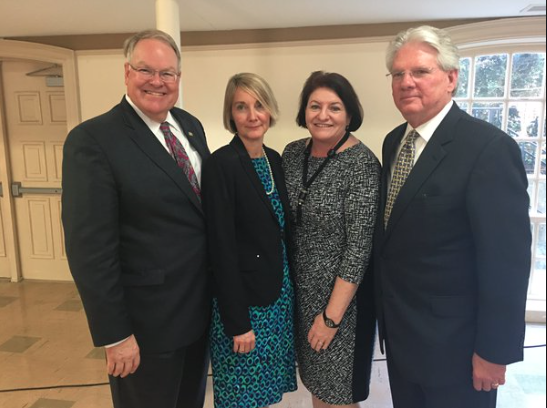Pam Kestner
A recent headline made an amazing announcement: Virginia has become the first state in the nation to functionally end homelessness for Veterans.
This news is not only great news for homeless Virginia vets, but it indicates that there are solutions that work. And that offers genuine hope for wider success for the problem of homelessness.
This news is of particular interest for the Emory & Henry community, because in 2012, Gov. Bob McDonnell named an E&H alumna to be Virginia’s Homeless Outcomes Coordinator. Pam Kestner (E&H Class of ’83) continues to serve Virginia in the McAuliffe administration, now under the title of Special Advisor on Families, Children, and Poverty within the Office of the Secretary of Health and Human Resources. Her work focuses on early childhood, nutrition, and issues related to poverty – particularly addressing homelessness in the Commonwealth.
Pam is careful to explain that the problem is “functionally” solved because the circumstances of life will always present situations that cause individuals to cycle in and out of homelessness. What Virginia has done is construct a system that will provide services and housing to solve a veteran’s homeless situation within a small window of time. (Read the full press release here.)
A plan to end homelessness could sound like the bluest of blue sky planning, when one considers the hurdles that exist and the changes that had to occur for them to declare success. But Pam contends the secret to this success was leadership. “Having the Governor behind the initiative meant that all the necessary agencies had to be on the same page and be pulling in the same direction.” Service providers also had to be on the page, funding had to be redirected, partnerships had to be established within the community, and new alliances had to be forged. The Governor’s Coordinating Council on Homelessness had worked the previous 4 years to create the foundation on which the “ending veteran homelessness” was built – and Pam was the person who coordinated the council. Pam explains that she and the council were not Houdini; she credits the many agencies and organizations at the state and local levels who worked collectively to achieve the desired outcome utilizing the Collective Impact Approach.
With this significant achievement, Pam isn’t saying, “Mission accomplished.” She is saying, “What’s next?” She explains that there are many factors that can lead a person to a homeless condition (everything from mental health to substance abuse to the economy to bad luck). But she has seen the data and the real life results and is quick to point out that people cannot succeed in turning around a bad situation without clean, safe, reliable housing. In the long run, she explains, it is more cost effective for a community to provide good housing to those in crisis than to continually supply temporary shelters – which usually go hand-in-hand with emergency medical assistance, police interaction, and additional crisis intervention. “Homelessness is a condition, and a symptom of a community, economy, and society in distress. Our challenge is to provide a solution for any individual who finds him- or herself in a housing crisis.”
Open gallery

“Homelessness is a condition, and a symptom of a community, economy, and society in distress. Our challenge is to provide a solution for any individual who finds him- or herself in a housing crisis.”